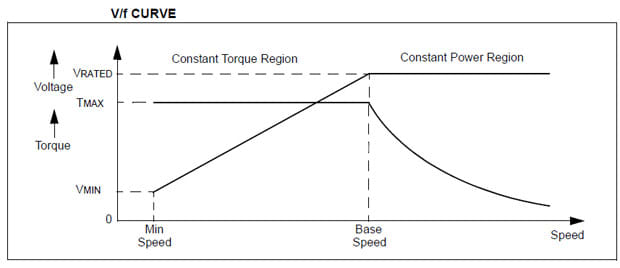It has taken me a long time to unlearn what I thought I knew about motors and running machine tools.
+1
I unlearn more often than I learn, seems like.
Using a modern sensorless vector VFD you can flatten the torque curve to produce nearly 100% rated torque from about 10 RPM up to the rated speed of the motor (constant torque mode), then above the rated speed the torque starts falling off (constant HP mode) until you reach the maximum rated RPM of the motor, at which point the motor is capable of producing very little torque.
This is something I recently unlearned (that section of quoted text could very well have been penned by my own hand just a couple of years ago). Maybe you can share some perspective/experience that will lead me to un-unlearn it? See, I believed in this "constant HP" mode as if it were something that happens automatically in the "field weakening" zone (>60Hz or nameplate frequency) because that's how all the graphs show it. EX:

But when I went out of my way to try and operate a VFD in this manner, what I found was something quite different. The application was a compressor; I didn't like how a "5HP" compressor doesn't live up to its name until right before it shuts off. So I put a VFD on it, and the idea was to set a 120Hz max frequency and let it run double speed until it starts to load up (until 5HP is reached, well below the pressure cutoff) and gradually slow down as pressure builds, following the above line labeled "Tmax" from right to left. That didn't happen. What happened was, it tried to deliver nameplate amps @ nameplate volts, at 120Hz, which overloaded the VFD. I found that this "constant power" mode is not something that
just happens naturally. I went on to find that it's not even a behavior you can program the drive to emulate (via normal parameters). I did eventually get it to work in my Yaskawa V1000 by utilizing it's integral PLC to monitor output watts and incrementally lower the speed reference as output power exceeds the drive's rating. It worked but it wasn't natural. Later I needed that Yaskawa for something else, so I subbed it for an AD GS2 VFD, and with that one I couldn't find a way to make it work at all with the VFD alone. I ended up having to bring an external PLC into the mix, to poll the VFD for its output current, voltage, and frequency, do the math, and decrease the speed reference to the drive as calculated output power was exceeded.
Maybe I repeatedly overlooked something simple? Have you ever observed this "constant power" mode in real life? If you have, I'd like to know what drive you were using and if it took any special parameter changes, or if it just happened naturally.
The down side of operating a standard 3 phase motor at near maximum torque and below the rated RPM is the potential of overheating.
Agreed, and another good reason to choose your forever-ratio near the low end, so that you always have enough RPM to stay cool.





